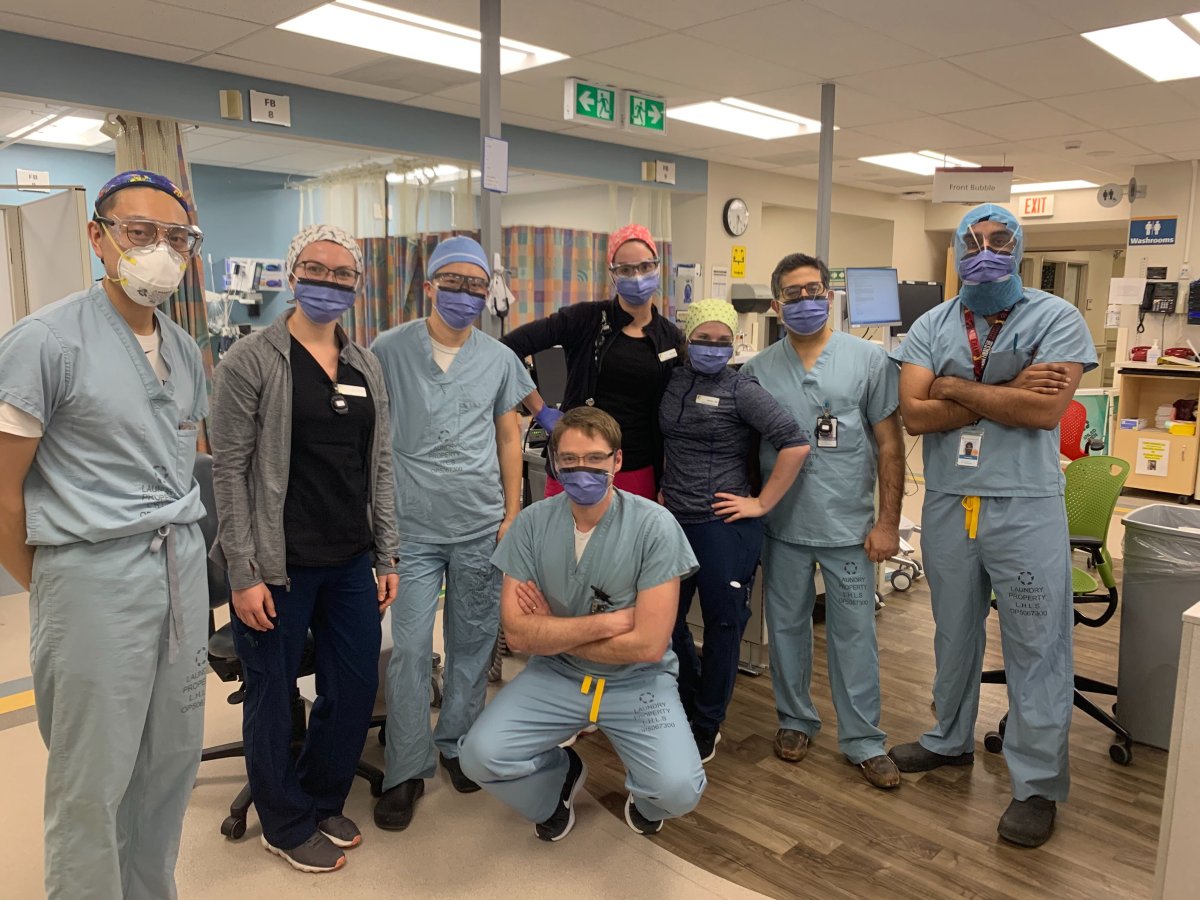Dr. Alex Dong doesn’t wear his wedding ring anymore when he goes to work at London Health Sciences Centre because it could become contaminated.

The only items he takes now are the essentials, like his phone and driver’s licence, which he locks safely away in a Ziploc bag that has to be sterilized before he leaves the hospital.
Once home, to keep from contaminating anyone or anything inside, he has to strip down in his garage and immediately jump into the shower.
It’s become the new normal for the emergency department physician and his colleagues at Victoria Hospital.
Similar stories are also playing out across the country as frontline medical staff, increasingly short on personal protective equipment, work to treat a growing number of COVID-19 patients, all while putting their own health — and that of their families — at risk.
No one working in Dong’s emergency department has gotten sick from COVID-19, at least not yet, Dong says. “Hopefully it stays that way.”
“The overall feeling is that this is kind of like the calm before the storm,” he says. “Overall, there’s a lot of anxiety amongst us, especially as more cases are coming in.
“For many of us, for the first time in our careers, we’re like, we’re scared to come to work.”
Ninety-two cases of COVID-19 and three deaths have been confirmed in London and Middlesex so far. Sixty-one cases and two deaths were reported just this work week.
Nineteen patients with COVID-19 were being treated at LHSC’s University and Victoria hospitals as of Friday, with 11 of those patients in intensive care.
“There’s probably a lot more cases of COVID-19 in the community than the official numbers would suggest,” Dong said. “We’re not testing everybody who comes in with symptoms. We’re telling them to self-quarantine at home and only to come back if things worsen and they need hospitalization.”
“Something that Dr. Theresa Tam, Canada’s chief public health officer, said the other day is that our confirmed numbers are probably a significant underestimate of the true number of people with COVID-19. So I really don’t want people thinking, ‘oh, there’s only like, whatever, 80 cases in London. It’s not that bad.'”
LHSC itself is readying itself for a potential influx.
Plans are in the works to convert the Western Fair District Agriplex into a temporary field hospital with 180 beds that could be expanded to 500 should the need arise, the organization said Friday.
“We are not at our peak yet. We’re still seeing our numbers rising,” Dong said. “We need to be more diligent with our social distancing to flatten that curve.”
According to provincial projections, if current health measures in place are upheld, Ontario could see just under 1,600 COVID-19 deaths and 80,000 cases by the end of April.
As for right now, everyone who walks in the door is presumed positive until proven otherwise, Dong said.
“I’ve never seen so many patients wearing, like, a gown and mask before.”
Those masks, along with other personal protective equipment (PPE), are becoming an increasingly precious resource as overtaxed doctors, nurses and hospitals struggle to manage the spike in COVID-19 cases while protecting themselves from infection.
“We need to preserve the current supply… That means that we need to ration,” Dong says. “And unfortunately, it means that we’re wearing the same masks for hours at a time or even one mask for the whole shift.”
Dong said he and his colleagues have been looking at potential alternatives amid the supply crunch, including ways to sterilize and reuse the protective masks and respirators they already have.
In addition, he says emergency staff have also begun using 3D-printed stethoscopes and face masks courtesy of their coworker, Dr. Tarek Loubani.
“But for now, we’re making do with what we have, and we’re trying to conserve as much as possible to stretch out our supply.”
Across southwestern Ontario, that supply appears to be becoming limited.
Figures obtained by the local nurses union and made public Thursday show southwestern Ontario hospitals are down to a five-day supply of surgical masks with face shields, and a seven-day supply of N95 1870 respirator masks.
Supplies are also limited in N95 8210 masks and N95 1860 masks, according to the figures, while N95 1870+ masks are unavailable.
In a joint statement Friday, Neil Johnson, acting president and CEO of LHSC, and Dr. Gillian Kernaghan, president and CEO of St. Joseph’s Health Care London, said the figures were “only a snapshot of what, in reality, is a complex and rapidly changing supply chain.”
“While a limited number of days-on-hand supply may seem concerning, it does not mean the hospitals will actually run out of stock at that time, but rather indicates an area of concern for our procurement partners,” the statement reads. “There are supply pipelines and fail-safes in place to ensure that all Ontario hospitals are able to access PPE.”
On the issue of having PPE rationed or conserved, the two state that while workers are being asked to be responsible with PPE use, “contrary to what has been publicly stated by some, we are not asking people to go without and we will not have staff or physicians working without proper PPE.”
Adding to the anxiety over PPE shortages, 3M, one of the world’s largest manufacturers of PPE, reported on Friday that it had been told by the White House to stop exporting N95 respirator masks to Canada and Latin America and prioritize domestic orders.
Premier Doug Ford said he’s protested to U.S. Trade Representative Robert Lighthizer, while Prime Minister Justin Trudeau has said blocking the exports would be a mistake.
Since the start of the week, more than 11 million face masks have arrived in Canada, including a shipment of one million masks that reached a Hamilton warehouse overnight, Trudeau said Thursday.
The government has spoken with nearly 3,000 companies to secure “millions of pieces of vital equipment,” he said.
— With files from The Canadian Press
Questions about COVID-19? Here are some things you need to know:
Health officials caution against all international travel. Returning travellers are legally obligated to self-isolate for 14 days, beginning March 26, in case they develop symptoms and to prevent spreading the virus to others. Some provinces and territories have also implemented additional recommendations or enforcement measures to ensure those returning to the area self-isolate.
Symptoms can include fever, cough and difficulty breathing — very similar to a cold or flu. Some people can develop a more severe illness. People most at risk of this include older adults and people with severe chronic medical conditions like heart, lung or kidney disease. If you develop symptoms, contact public health authorities.
To prevent the virus from spreading, experts recommend frequent handwashing and coughing into your sleeve. They also recommend minimizing contact with others, staying home as much as possible and maintaining a distance of two metres from other people if you go out.
For full COVID-19 coverage from Global News, click here.












Comments